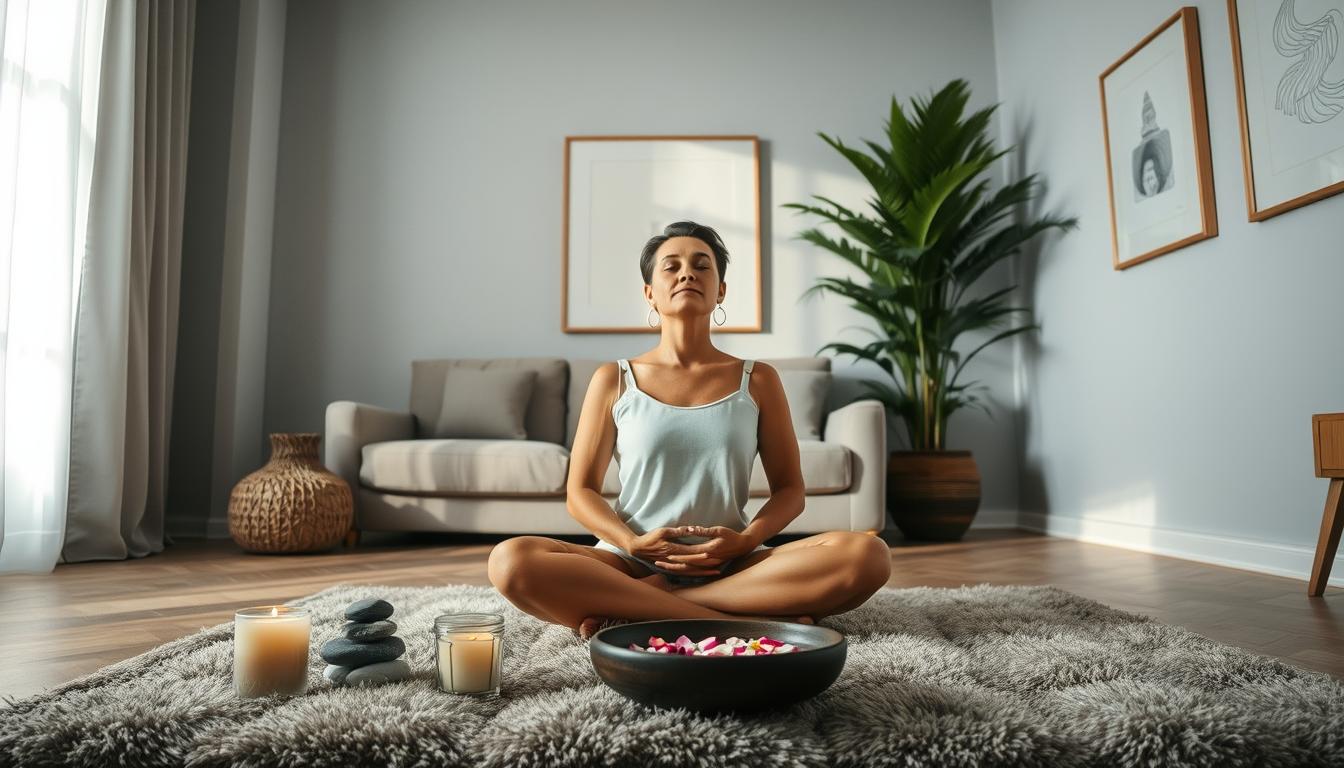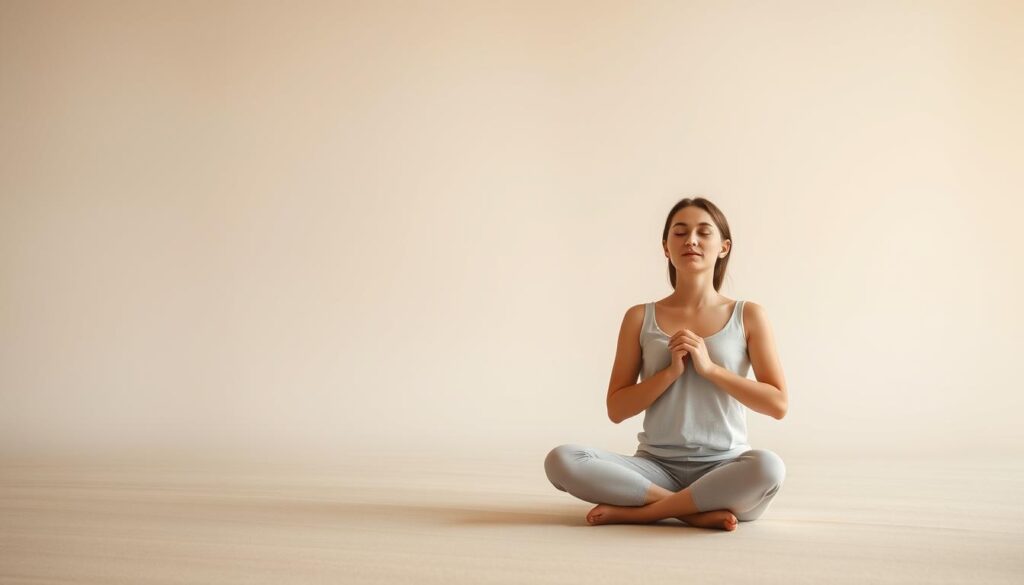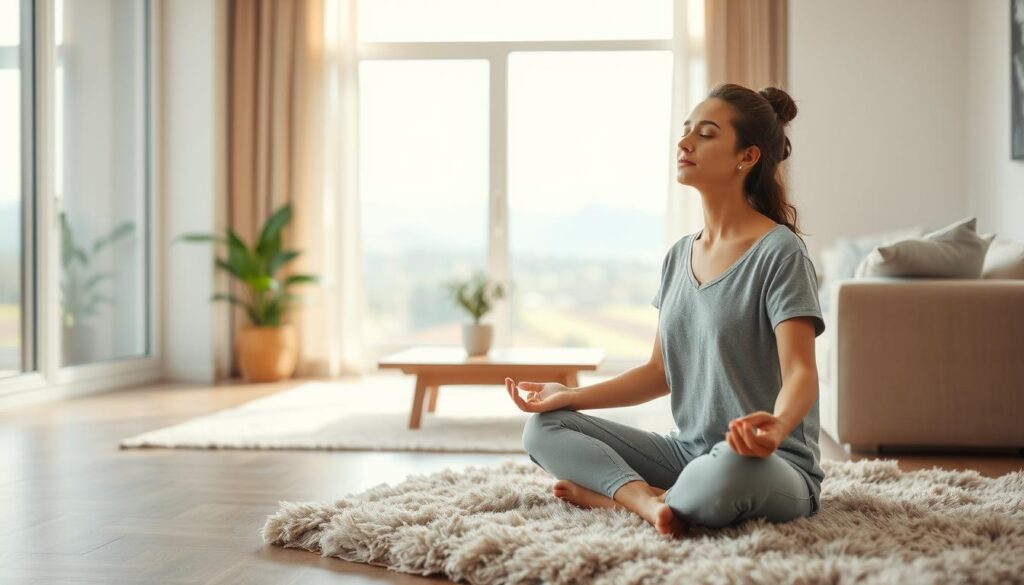Grounding Techniques: Simple Ways to Feel Centered and Focused
Ever felt like stress or anxiety is pulling you away from the present? You’re not alone….

Ever felt like stress or anxiety is pulling you away from the present? You’re not alone. Many of us find it hard to stay grounded in today’s fast world. Simple relaxation methods can help.
Mindfulness exercises are a great way to bring your focus back to the present. They calm your mind and soothe your body. Adding these exercises to your daily routine can make you more resilient to stress and anxiety.
Key Takeaways
- Discover simple ways to feel more centered and focused
- Learn effective stress relief techniques to calm your mind and body
- Explore the benefits of mindfulness exercises for overall well-being
- Find out how to incorporate relaxation methods into your daily routine
- Develop greater resilience to stress and anxiety
What Are Grounding Techniques?
Grounding techniques help you stay in the present moment. They reduce stress and anxiety. These methods use your senses to distract you from negative thoughts and feelings.
Definition of Grounding Techniques
Grounding techniques are emotional regulation tools. They help you manage overwhelming emotions by focusing on the present. Simple actions like deep breathing or paying attention to your surroundings can help.
These techniques calm your mind and body. They make it easier to handle stressful situations.
Some common grounding techniques include:
- Deep breathing exercises
- Progressive muscle relaxation
- Sensory awareness practices
- Mindfulness meditation
Importance of Grounding in Daily Life
Grounding techniques are key in daily life. They offer anxiety management techniques and self-soothing methods. By practicing grounding, you can better manage your emotions.
It can also reduce symptoms of anxiety and depression. Plus, it boosts your overall well-being.
Incorporating grounding into your daily routine is beneficial. It can help you:
- Manage stress and anxiety better
- Improve your focus and concentration
- Enhance your emotional resilience
By making grounding a daily habit, you gain a powerful tool. It helps you face life’s challenges with more ease and confidence.
Benefits of Using Grounding Techniques
Grounding techniques can greatly improve your mental health. They help you stay in the present moment. This can lower anxiety and stress, improve focus, and better manage emotions.
Reducing Anxiety and Stress
Grounding techniques are great for reducing anxiety and stress. They help you focus on the now, calming your mind and body. This can lessen the physical signs of anxiety.
A study showed that using these techniques can lower anxiety and depression symptoms. Grounding techniques are a simple way to manage stress and anxiety, helping to calm your mind and body.
“Grounding techniques can help individuals manage stress and anxiety by providing a sense of control and calm.”
Improving Focus and Concentration
These techniques can also boost your focus and concentration. They train your mind to stay present. This improves mental clarity and reduces distractions.
A table comparing the effects of grounding techniques on focus and concentration is shown below:
| Technique | Effect on Focus | Effect on Concentration |
|---|---|---|
| Deep Breathing | Improves mental clarity | Enhances ability to concentrate |
| Progressive Muscle Relaxation | Reduces mind-wandering | Improves focus on tasks |
| Sensory Awareness | Enhances sensory perception | Improves attention to detail |
Enhancing Emotional Regulation
Grounding techniques also help with emotional regulation. They keep you connected to the present. This reduces emotional reactions and improves emotional health.
Regular practice of grounding techniques can lead to improved emotional stability. This makes it easier to handle life’s challenges.
Types of Grounding Techniques
To effectively ground yourself, it’s key to know the different types of grounding techniques. These can be physical, mental, or emotional. Each type has its own role in managing stress and anxiety.
Physical Grounding Methods
Physical grounding uses your senses to keep you in the present. It includes deep breathing, muscle relaxation, and paying attention to your surroundings. These methods help shift your focus from worries to the here and now.
A mindfulness expert says, “Paying attention to your breath or the sensation of your feet on the ground can be incredibly grounding.” Physical methods are great for panic attacks or feeling too much.
Mental Grounding Techniques
Mental grounding distracts your thoughts from anxiety. It includes visualization, mindfulness meditation, and stopping negative thoughts. These methods calm your mind and lessen overwhelm.
- Visualization exercises involve imagining a peaceful scene or activity.
- Mindfulness meditation focuses on being present in the moment.
- Thought-stopping methods help interrupt negative thought patterns.
Emotional Grounding Strategies
Emotional grounding helps manage your feelings and reduce distress. It includes journaling, self-compassion, and building a support network. These strategies help you better understand and handle your emotions.
Dr. Kristin Neff, a self-compassion expert, says, “Self-compassion involves being kind to yourself in the midst of difficulty.” Being kind to yourself is a strong emotional grounding strategy.
Physical Grounding Techniques
Physical grounding techniques can calm your body and mind when things get tough. They help you stay in the present moment. This reduces feelings of distress and anxiety.
Deep Breathing Exercises
Deep breathing is a simple yet powerful way to calm down. It slows your heart rate and lowers stress. To do it, sit comfortably, breathe in deeply through your nose, hold it for a few seconds, and then breathe out slowly through your mouth.
Benefits of Deep Breathing:
- Reduces anxiety and stress
- Improves oxygen flow
- Enhances focus and concentration
Progressive Muscle Relaxation
Progressive muscle relaxation involves tensing and relaxing muscles. It helps release tension and promotes relaxation. Start by tensing your toes, hold for a few seconds, and then release. Move up your body, tensing and relaxing each muscle group.
Sensory Awareness Practices
Sensory awareness practices use your senses to ground you in the present. This can include noticing your surroundings, body sensations, or sounds. For example, take a moment to feel your feet on the ground, listen to nature, or feel the air on your skin.
Examples of Sensory Awareness Practices:
- Noticing the sensation of your feet touching the ground
- Listening to the sounds around you
- Paying attention to the sensation of the air on your skin
By adding these techniques to your daily life, you can better manage stress and anxiety. This leads to a more balanced and fulfilling life.
Mental Grounding Techniques
Practicing mental grounding techniques can help you deal with overwhelming feelings. These techniques help you shift your thoughts and manage tough emotions. They bring you back to the present moment.
Visualization Exercises
Visualization is about creating a mental picture of a peaceful place. Find a quiet spot, close your eyes, and imagine a place where you feel relaxed. It could be a beach, a forest, or any place that calms you.
For example: Imagine walking on a serene beach at sunset. Notice the sound of waves, the sand’s warmth, and the salty air’s smell. As you imagine, release all tension and stress.
Mindfulness Meditation
Mindfulness meditation helps you stay present. It’s about noticing your thoughts, feelings, and sensations without judgment. Start by sitting comfortably, closing your eyes, and focusing on your breath. If your mind wanders, gently bring it back to your breathing.
Tips for mindfulness meditation:
- Start with short sessions (5-10 minutes) and increase as you get comfortable.
- Use a guided meditation app if you’re new to meditation.
- Practice regularly to see the full benefits.
Thought Stopping Methods
Thought stopping helps stop negative thoughts. When you notice negative thinking, say “Stop” or use a mental image like a red light. Then, focus on something positive or neutral, like a hobby or a task.
The following table summarizes the mental grounding techniques discussed:
| Technique | Description | Benefits |
|---|---|---|
| Visualization Exercises | Creating a mental image of a peaceful place | Reduces stress, promotes relaxation |
| Mindfulness Meditation | Focusing on the present moment without judgment | Improves focus, reduces anxiety |
| Thought Stopping Methods | Interrupting negative thought patterns | Breaks cycle of negative thinking, improves mental clarity |
Emotional Grounding Strategies
Practicing specific grounding techniques can help you find emotional balance. These strategies help manage your emotions, lessen distress, and boost your well-being.
Identifying Emotions with Journaling
Journaling is a great way to understand your emotions. Writing down your thoughts and feelings helps you process and release them. Set aside a few minutes each day to write about your experiences, thoughts, and emotions.
Tips for Effective Journaling:
- Be honest and authentic in your writing.
- Explore your emotions without judgment.
- Reflect on your experiences to identify patterns.
Practicing Self-Compassion
Self-compassion means treating yourself with kindness and patience. It’s about being gentle with yourself, even when you’re feeling down. Acknowledge your feelings and remind yourself it’s okay to feel overwhelmed.
Example of self-compassion: “I’m feeling overwhelmed right now, and it’s okay. I’m doing the best I can.”
Building a Supportive Network
A supportive network of friends, family, or a therapist can offer emotional support. Sharing your feelings with others can make you feel heard and understood. This can reduce feelings of loneliness and isolation.
| Supportive Network | Benefits |
|---|---|
| Friends and Family | Emotional support, practical help |
| Support Groups | Shared experiences, community |
| Therapists or Counselors | Professional guidance, coping strategies |

How to Choose the Right Grounding Technique
To get the most out of grounding techniques, you need to assess your needs and preferences carefully. Choosing the right grounding technique involves understanding what works best for you and your specific situation.
Assessing Your Current Needs
Before selecting a grounding technique, it’s essential to assess your current needs. Consider what you’re experiencing: Are you feeling anxious, stressed, or overwhelmed? Identifying your emotional state can help you choose a technique that addresses your specific needs.
Key questions to ask yourself:
- What are my most common triggers?
- How do I typically respond to stress or anxiety?
- What environments or situations make me feel most grounded?
Trying Different Techniques
There’s no one-size-fits-all approach to grounding techniques. It’s crucial to try different methods to see what works best for you. You might find that a combination of physical, mental, and emotional grounding techniques is most effective.
Some techniques to consider:
- Deep breathing exercises
- Progressive muscle relaxation
- Mindfulness meditation
- Visualization exercises
Creating a Personalized Grounding Plan
Once you’ve identified techniques that work for you, create a personalized grounding plan. This plan should include a variety of techniques to use in different situations. Having a plan in place can help you feel more prepared and in control.
Tips for your plan:
- Identify specific techniques for different scenarios
- Practice your techniques regularly
- Keep a journal to track your progress and adjust your plan as needed
By following these steps, you can develop a grounding practice that is tailored to your needs, helping you to stay centered and focused in your daily life.
Grounding Techniques for Anxiety Relief
When anxiety hits, having good grounding techniques is key. These methods help you stay in the present. They can lessen anxiety and panic, making you feel better overall.
Quick Grounding Exercises for Panic Attacks
Quick exercises are vital during panic attacks. The 5-4-3-2-1 technique is one. It asks you to notice five things you see, four things you touch, and so on. This distracts you from anxiety and keeps you grounded.
Deep breathing is another fast way to calm down. Take slow, deep breaths in and out. It can slow your heart and ease anxiety.
Using Nature for Grounding
Nature is great for grounding. Being outside, like in a park or your backyard, connects you to now. Pay attention to the sounds and smells around you, like birds or flowers.
“Nature is not a place to visit. It is home.” – Gary Snyder
Incorporating Grounding Into Routine
Adding grounding to your daily life helps with anxiety. Spend a few minutes each day on it, like meditating or breathing deeply. Doing it regularly makes it a habit.
- Begin your day with a grounding exercise, like deep breathing or a quick meditation.
- Take short breaks to practice grounding, like deep breaths or noticing your surroundings.
- Make grounding part of your daily activities, like feeling your feet on the ground while walking.
Grounding Techniques for Everyday Life
Grounding techniques can be used in many parts of your life. This includes work, social interactions, and even at home. These simple methods help you stay focused and improve your well-being.
Grounding Practices for the Workplace
Work can be stressful for many people. Using grounding techniques at work can help. For example, deep breathing exercises can calm your mind and lower anxiety.
Try sensory awareness practices too. Notice how your feet feel on the ground or the sounds around you. This helps you stay grounded.

Grounding in Social Settings
Social situations can sometimes feel overwhelming. Grounding techniques can make these situations easier. Focus on the present moment by using your senses.
Notice the taste of your drink or the air on your skin. This helps you stay calm and composed.
Integrating Grounding Into Family Life
Grounding techniques are also good for family life. They help create a peaceful and connected home. Try mindfulness meditation together to bond and reduce stress.
Also, do activities that make you aware of your senses. Like going for a walk or playing a family game night. This keeps everyone grounded and happy.
Using grounding techniques in your daily life can greatly reduce stress. They improve your overall well-being. Whether at work, in social situations, or at home, these methods keep you centered and focused.
Tips for Practicing Grounding Techniques
Grounding techniques work best when done regularly. They help improve your mental health and make you more resilient to stress and anxiety. By adding these practices to your daily routine, you can see real benefits.
Setting Aside Time for Grounding
It’s important to make time each day for grounding. Begin with short sessions, like a few minutes, and increase the time as you get more comfortable.
Try to do grounding at the same time every day. This could be in the morning or before bed. Sticking to a routine helps make it a habit.
Being Patient with Yourself
Patience is key when learning grounding techniques. It’s okay if it’s hard to stay focused or if you feel like you’re not doing it right.
The goal of grounding is to be present in the moment. Be kind to yourself and remember it takes time to get better at this.
Keeping a Grounding Techniques Journal
Writing down your grounding experiences can be very helpful. It lets you see how you’ve improved and which techniques work best for you.
Reflecting on your journal can help you fine-tune your grounding practice. This way, you can make it even more effective in your life.
Conclusion: Embracing Grounding Techniques
Grounding techniques are simple yet powerful. They can greatly improve your mental health and well-being. By adding grounding to your daily routine, you can lessen anxiety and depression symptoms. You’ll also find it easier to manage your emotions and feel better overall.
Key Takeaways
Grounding techniques offer many benefits. They help you stay focused, reduce stress, and feel calmer. If you’re dealing with anxiety, need better emotional control, or just want to feel more grounded, these techniques can help.
To get the most from grounding, be consistent and patient. Start with one or two techniques each day. Try different ones to see what works best for you. Regular practice will help you become more aware and improve your well-being.
Embracing grounding techniques is a great step towards a more balanced life. Start your grounding journey today. See how it can positively change your life.
FAQ
What are grounding techniques, and how can they help me?
Grounding techniques are simple exercises that help you feel more centered and focused. They reduce anxiety and stress. These techniques can improve emotional regulation and overall well-being.
How do I choose the right grounding technique for my needs?
To choose the right technique, assess your current needs and try different ones. Create a personalized grounding plan. Experiment with physical, mental, and emotional techniques to find what works best for you.
What are some examples of physical grounding techniques?
Physical techniques include deep breathing, progressive muscle relaxation, and sensory awareness. These can reduce stress and anxiety, improving your overall well-being.
Can grounding techniques be used in daily life?
Yes, you can use grounding techniques in daily life. They can help in the workplace, social settings, and family life. They improve well-being, reduce stress, and enhance emotional regulation.
How can I incorporate grounding techniques into my daily routine?
Set aside time for grounding and be patient with yourself. Keep a journal of your grounding practices. Try to incorporate them into your daily activities, like morning meditation or before bed.
Can grounding techniques help with anxiety relief?
Yes, they can help with anxiety relief. Quick exercises, using nature, and routine incorporation can reduce anxiety symptoms and panic attacks.
How can I practice emotional grounding strategies?
Emotional grounding includes journaling emotions, practicing self-compassion, and building a supportive network. These strategies improve emotional regulation and overall well-being.
What are some mental grounding techniques I can try?
Mental techniques include visualization, mindfulness meditation, and thought stopping. These can improve mental health, reduce anxiety and depression symptoms, and enhance well-being.
